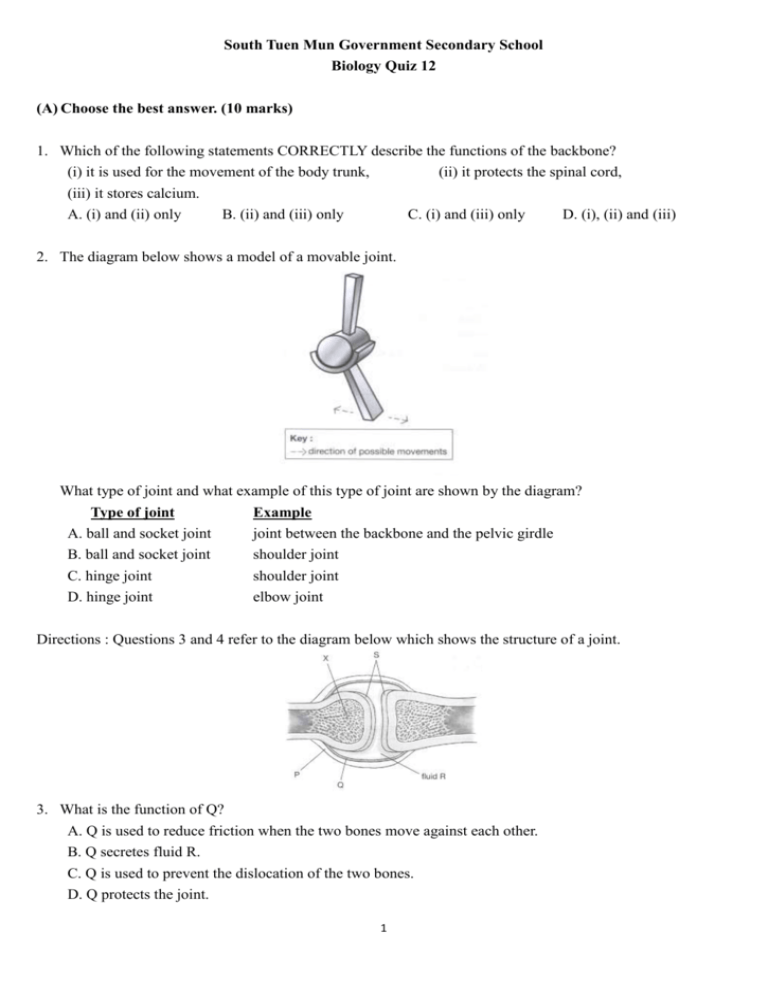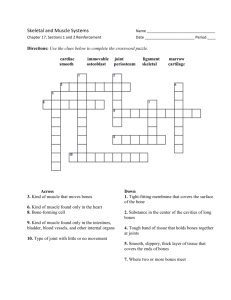Quiz 12
advertisement

South Tuen Mun Government Secondary School Biology Quiz 12 (A) Choose the best answer. (10 marks) 1. Which of the following statements CORRECTLY describe the functions of the backbone? (i) it is used for the movement of the body trunk, (ii) it protects the spinal cord, (iii) it stores calcium. A. (i) and (ii) only B. (ii) and (iii) only C. (i) and (iii) only D. (i), (ii) and (iii) 2. The diagram below shows a model of a movable joint. What type of joint and what example of this type of joint are shown by the diagram? Type of joint A. ball and socket joint B. ball and socket joint C. hinge joint D. hinge joint Example joint between the backbone and the pelvic girdle shoulder joint shoulder joint elbow joint Directions : Questions 3 and 4 refer to the diagram below which shows the structure of a joint. 3. What is the function of Q? A. Q is used to reduce friction when the two bones move against each other. B. Q secretes fluid R. C. Q is used to prevent the dislocation of the two bones. D. Q protects the joint. 1 4. Structure S and fluid R have one common function. The common function is A. to reduce friction between the two bones. B. to produce red blood cells. C. to store lipid. D. to hold the two bones in position. Directions : Questions 5 and 6 refer to the following information. Some drugs act on the neuromuscular junction. They affect the action of chemical transmitter between the nerve ending and the receptors of the skeletal muscle. The table below shows the effect of four different drugs. Drug Effect of the drug P reduce the speed of the breakdown of the chemical transmitter Q inhibit the release of the chemical transmitter from the nerve ending R compete with the neurotransmitter for the receptors of the skeletal muscle S increase the rate of the breakdown of the chemical transmitter 5. Some patients suffer from uncontrolled muscle contraction. Which drugs help the patient to reduce the muscle contraction of the patient? A. drugs P and Q only B. drugs P and R only C. drugs Q, R and S only D. drugs P, Q, R and S 6. Which of the drugs can be used to increase the stimulation of muscle contraction? A. drug P B. drug Q C. drug R D. drug S 7. In man, homeostasis means A. to maintain a constant external environment. B. to regulate and maintain a constant internal condition in the blood. C. to slow down the metabolism of the cells. D. to increase the rate of enzymatic reactions. 8. Which of the following comparisons between insulin and glucagon is CORRECT? Insulin A. It is an enzyme. B. It catalyses the conversion of glucose to glycogen. C. It decreases the blood glucose level. D. It is transported by blood. Glucagon It is a hormone. It catalyses the change of glycogen into glucose. It increases the blood glucose level. It is transported by duct. 9. At time 0, a diabetic patient drank a glass of glucose solution. Which of the following graphs CORRECTLY shows the change in his / her blood glucose level? 2 10. For a diabetic patient, carbohydrate in the form of starch is better than simple sugar (such as glucose) as food in a meal. It is because A. simple sugars are absorbed faster than starch. B. simple sugar will be excreted in urine, while starch cannot. C. starch has a higher energy value than simple sugars. D. blood glucose level will not increase very fast if starch is eaten, as compared to simple sugar. (B) Answer the following questions. (30 marks) 1. The following diagram shows a man using his left leg to kick a ball. (a) Using the letters given, (i) state the skeletal muscle(s) which contract(s) to straighten the knee and the ankle. (1 mark) (ii) state the skeletal muscle(s) which contract(s) to bend the knee and the ankle. (1 mark) (b) A student, Tom, said “Opposing muscles work in pairs when one muscle expands and the other constricts”. Comment on her statement. Explain briefly. (3 marks) 2. Diagram I below shows the arrangement of bones and muscle in the upper limb and diagram II shows the structure of joint 2. 3 (a) (i) Name structure C. (ii) Describe the function of structure C. (b) State the difference in the degree of movement allowed by joint 1 and joint 2. (1 mark) (2 marks) (2 marks) (c) Describe the physical property of A. Explain the significance of this property to its function. (2 marks) (d) When a man is lifting up a heavy box as shown in Diagram I, draw a diagram to show the lever system, showing the positions of the load, effort and the fulcrum of the lever. (3 marks) 3. The electron micrograph below shows part of a neuromuscular junction: (a) What type of neurone is involved in the neuromuscular junction? (b) (i) What is structure B? (1 mark) (1 mark) (ii) State what happens to structure B when a nerve impulse arrives. (c) (i) What is structure C? (ii) Describe the function of structure C in the neuromuscular junction. (1 mark) (1 mark) (4 marks) 4. The following chart below shows the process of coordination in man. (a) What kind of feedback mechanism is shown by the above flow chart? (1 mark) (b) With reference to the above flow chart, identify the stimulus, coordinating centre and response respectively when the blood glucose level is too high in a healthy man. (3 marks) (c) (i) For some diabetic patient, injection of insulin does not work. Explain why. (1 mark) (ii) Apart from insulin injection, suggest TWO ways that may help the patient to control their blood glucose level. (2 marks) 4 South Tuen Mun Government Secondary School Biology Quiz 12 Marking Scheme (A) Choose the best answer. (10 marks) 1. D 2. D 6. A 7. B 3. B 8. C 4. A 9. B 5. C 10. D (B) Answer the following questions. (30 marks) * spelling must be correct 1. (a) (i) P and S (1) (ii) Q and R (1) (b) His statement is wrong (1) because muscle does not expand and constrict, it contracts (1) and relaxes (1). 2. (a) (i) C – * ligament (1) (ii) C / ligament is used to hold the two bones in position (1) so as to prevent the dislocation of joint (1). (b) Joint 1 allows movement in all directions / in three planes (1) while joint 2 allows movement in one plane (1). (c) A is tough / inelastic (1), so it can correctly transmit the force / pull of the skeletal muscle to the bone (1). (d) correct diagram (1), correct label (½ x 3 = 1½), correct title (½) 3. (a) * motor neurone (1) (b) (i) muscle fibre (1) (ii) it contracts (1) (c) (i) synaptic * vesicle (1) (ii) The vesicle contains a neurotransmitter / chemical transmitter (1). When a nerve impulse arrives, the vesicle releases the neurotransmitter / chemical transmitter (1). The neurotransmitter / chemical transmitter diffuses across the synaptic cleft (1) and binds with the receptors on the skeletal muscle (1) causing the skeletal muscle to contract (1). [Any 4 – maximum 4 marks] 4. (a) negative feedback mechanism (1) (b) stimulus – high blood glucose level (1); coordinating centre – pancreas (1); response – reduction of blood glucose level / more glucose is changed to glycogen in the liver (1) (c) (i) This is because the patient’s liver cannot respond to insulin / does not have receptors to bind with insulin (1). (ii) Doing regular exercise (1), intake of less sugary food (1) 5








